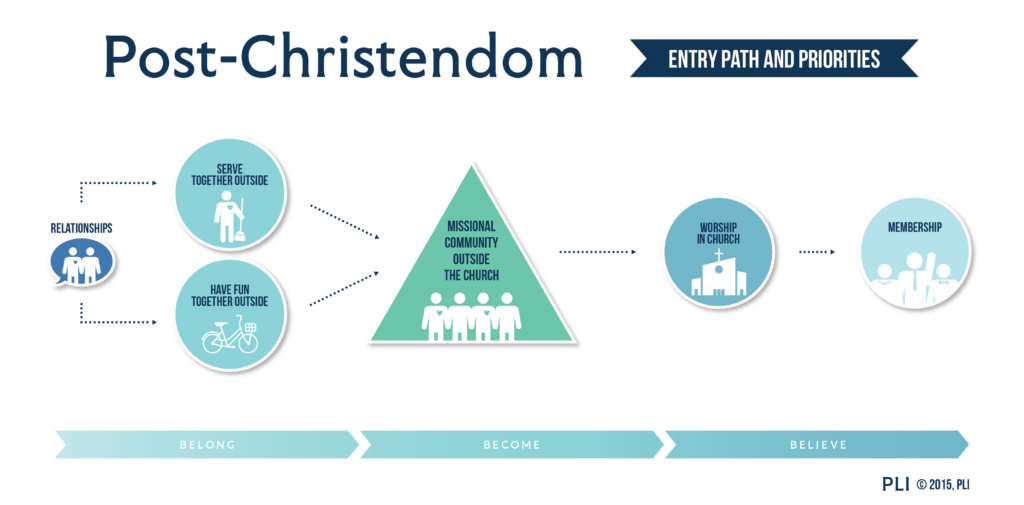There’s a growing discontent that adults in their 20s, 30s and even 40s are mostly absent in our churches…and maybe absent from faith in Christ. Many are discouraged that large portions of most communities have no interest in what’s inside the church.
A while ago I started the “napkin test” on the two entry paths you see below. I was consistently encouraged by the reactions I received. Actually, I was more encouraged by the “now I get it” type of response.
Let’s look at two “entry paths,” certainly simplified, intended to illustrate how “outsiders” make their way into our ministries and/or into faith.
Both deserve more explanation than they’ll receive here. The first is a familiar one, and well practiced for sure. It centers around Sunday worship and preaching.

In most churches these things will continue to be important, not only for those already gathering but also for those congregations that want to welcome Christians moving (transferring?) from other communities and congregations. And it’s important for those who used to go to church but stopped for a reason, who still look for the semblance of what they knew.
The “napkin test” response:
“Still important.”
“Need to keep it.”
“Isn’t ‘working’ like it used to work.”
That growing discontent about the absent noted above.
The good news is that more and more people of God are longing to see the generation of their kids and grandkids reached with the Gospel of Christ.
They’re not content to see a generation lost and they’re willing to act. Right?
If they knew what to do….

This path…not so familiar, if at all…centers around gatherings of people tagged “missional community.”
Since we’re being unfairly simple: Missional community is a little bit like what I remember about Thanksgiving when I was a kid. Grandpa and Grandma Ficken invited all five of their kids and their families. Food. A family prayer. Talk about gratitude to God and a good harvest (it was Thanksgiving on the farm). A few might have reflected on the sermon and singing at church that morning. Conversations. Cards. Cleaning up. Cousins and football on the Methodist church lawn. And when you went home? You knew that you belonged and that you were loved.
It’s an incomplete illustration, but a start.
It assumes the world is not waiting for a sermon; they’re waiting for a life, and a community that’s living what they’re believing and willing to be and bring “good news” to those without it.
The “napkin test” response:
“If my two sons ever come back to church it will be this path.”
“Serving together on a mission trip was when my own life turned around.”
“This gives me hope. Our church could do this!”
Here’s the beauty of this path:
Churches don’t need to abandon what they’ve always done and loved, even if it’s not demonstrating the fruit it once did, to venture into this new world.
It doesn’t take a new building or even a larger budget. No new staff person or strategic plan. It takes a leader with a vision, enough training and support to navigate the new, and missional zeal that’s not willing to settle for obsolescence in the Kingdom.
This navigating the familiar and exploring the new very well could be the greatest leadership challenge any of us will face!
Let me ask four things of you!
- What do you think of these entry paths? Share your response in the comments!
- Do your own “napkin test” and forward it to a few of your leaders and ask them what they think!
- PLI is committed to investing in leaders to press into the missional frontiers around every one of our congregations. Explore if one one of our Learning Communities is right for you or contact Raechel Pfotenhauer today for more information about the Learning Communities starting this fall.
- Make a gift today that invests in the women and men of God who are eager to bring hope and courage and leadership to their congregations so they might bear abundant fruit in the Kingdom!
I’m watching leaders do exactly that every day in the PLI family! And I am encouraged!
by Rev. Dr. Jock Ficken
originally published in 2018




0 Comments